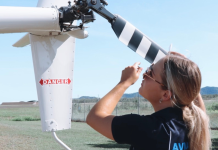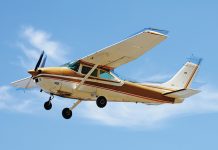It’s 5 am when the alarm goes off. You look outside and realise it’s going to be a great day for flying.
You pack your flight bag, have a quick bite to eat and head off. However, it’s quite a drive to the aerodrome and, as you get closer, you see large grey clouds forming. They weren’t on last night’s forecast!
When you arrive, the chief pilot says that due to the unexpected cloud cover, your flight is cancelled. What a bummer – you had been looking forward to this all week and you had driven all this way.
If you are a VFR-rated pilot, you will not be planning to fly into clouds, like on the day described above.
You know from consulting CASA’s Visual Flight Rules Guide that your visibility must be at least 5 kilometres below 10,000 feet in Class G. And you must always have the required vertical and horizontal separation from cloud or stay clear of cloud below 3,000 feet AMSL (or 1,000 feet AGL) to stay legal.
However, an option exists for pilots who want to take the next step and fly under instrument flight rules (IFR) – it is the private instrument rating (PIFR).
What is it?
An instrument rating allows pilots to operate in IMC (that is, any weather other than VMC!). That is significant. It means you can take off when the weather is overcast, punch up through the clouds and fly in bright sunshine, looking down on the solid blanket of clouds. When you arrive at top of descent, you can safely let down through the clouds and emerge from the soup, with the aerodrome directly ahead.
The PIFR is a uniquely Australian endorsement, with CASA being the only aviation safety regulator to offer this rating to private pilots. Other regulators require pilots get their full instrument rating if they wish to fly in IMC conditions.
In contrast, the PIFR is a great option for those pilots who want to take their flying journey to the next level but don’t want to commit to undertaking study for an instrument rating (IR) – formerly known as the command instrument rating – required for commercial operations.
Catherine Fitzsimons, Head of Operations at WardAir in Bathurst which has been offering the PIFR for several years, is a strong advocate for the rating.
‘The private instrument rating is not a lower class of rating, it’s a modular rating allowing the candidate to select the procedures to be taught based on, for example, the equipment in their aircraft’ Fitzsimons says.
‘Whereas an instrument rating requires training and proficiency on all navigation aids and procedures, the private instrument rating can be issued for a subset of these. The flying standards required to pass the flight test are still the same as those for the instrument rating, but the hours of training and the breadth of the syllabus can be narrower and can also be extended at a later stage.
‘The beauty of the private instrument rating is that it allows a private pilot to select just a small number of endorsements and then become proficient because they’re the only ones they fly and practise regularly. For example, I don’t believe there is an aerodrome in Australia with instrument approaches that doesn’t include an RNP approach.
‘So, a private pilot can be very proficient on one kind of approach and also proficient on the basic enroute instrument flying procedures, and that might be all that they have.’
What are the benefits?
Choosing which instrument rating to train for can be a confusing process. The key to determining what suits you best will be based on the type of flying you intend to do. Will you be flying every day for a year? Do you fly as part of an aeroclub? Do you only fly twice in as many months?
The benefit of the PIFR is its flexibility. The base rating covers en route with at least one navigation aid, normally GNSS.
As Fitzsimons says, the rating is modular and you can choose which phases of flight you want to get endorsed in – departure, arrival, RNP approach, ILS, additional navigation aids for en route (cruise), or night flying.
Determining which endorsement may depend on where you live; for instance, in many parts of Australia, the topography means there is higher propensity for cloud to form and linger; therefore, a departure and approach rating might be beneficial in addition to the basic en route endorsement.
‘Students might add a departure endorsement, and also a night endorsement, it depends on how much flying they do and the type of flying they do,’ Fitzsimons says.
‘The PIFR allows them to choose what their rating looks like and then be very competent and proficient in just those areas – and that’s got to be a recipe for safety.’
I don’t believe there is an aerodrome in Australia with instrument approaches that doesn’t include an RNP approach.
The PIFR is also more cost effective than an instrument rating for private pilots who fly less regularly. Generally, the cost is $10,000–12,000, covering the theory course, written exam and flight test.
There are also 2 pathways towards the rating – you can study for the private IFR rating exam (PIFR) or study for the instrument rating exam (IREX). The first option can be completed in about 20 hours, compared to 40 for the IREX.
The IREX exam covers everything in the PIFR exam and goes further. And, importantly, the IREX is a prerequisite for the command rating. So, if you’re considering doing the private instrument rating and later upgrading to the command rating, it would be more efficient to do the IREX straightway.
CASA Aviation Safety Advisor Tim Penney says it’s important for PIFR holders to maintain
currency for their safety.
‘It is also important not to confuse recency with competency,’ he says. ‘Just because you might be legally able to carry out an activity, does not automatically mean you are competent to do so.
‘I suggest you aim for more than the minimum recency requirements. Practise your skills regularly, perhaps ‘under the hood’ with a safety pilot and on your home SIM.
‘So then, if overcast conditions form unexpectedly at your destination airport and you need to do an RNP approach in ‘real’ IMC, that should be the only surprise of the day.’ 
How can I take the next step?
Several flight training organisations around Australia offer both pathways, covering the written and flight-testing components.
Your research will point to which organisation and which program best suit your needs.
The CASA website provides prospective students with guidance, including helpful tips for taking the PIFR exam, a list of items that candidates can take into the exam, pass rates and common errors that previous participants found challenging. casa.gov.au





